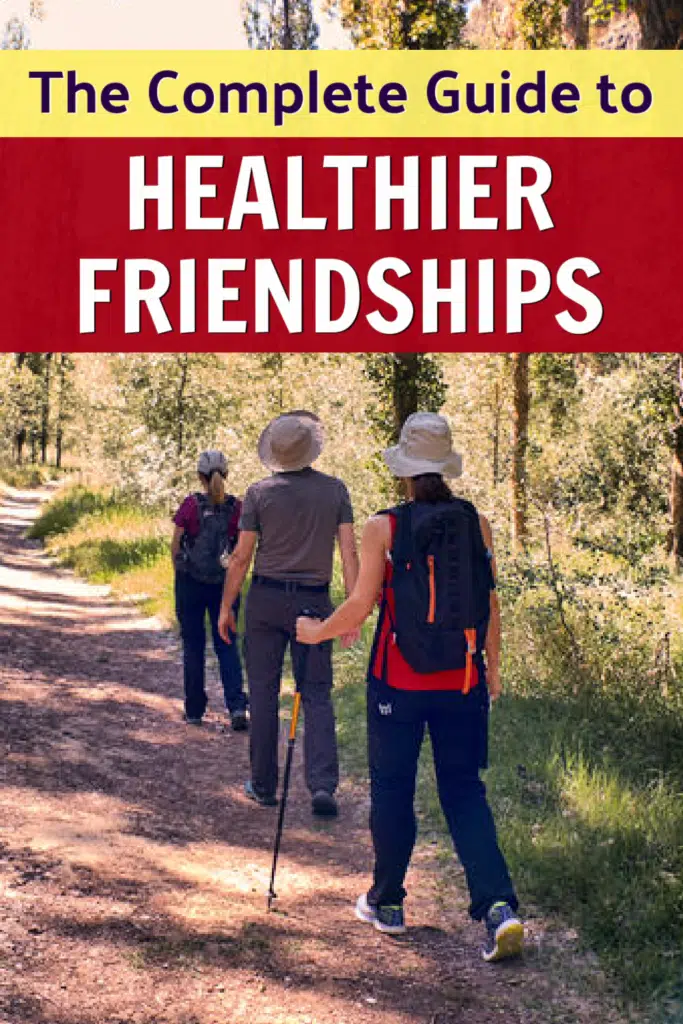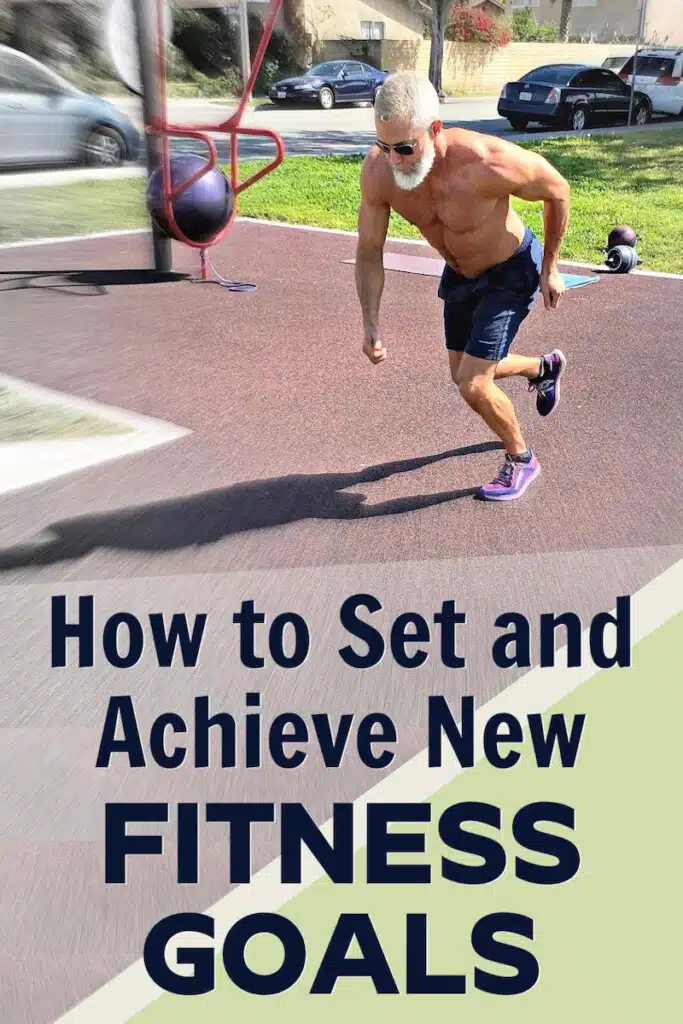The quest for new fitness friendships can be challenging as we age. However, building meaningful friendships over 50 that support healthier habits is far from impossible.
This comprehensive guide can help you forge healthier friendships and boost your social life in your mature years, whether you lean towards introversion or extroversion.
What Are Fitness Friendships?
A “fitness friendship” is a relationship where two or more individuals connect and support each other in their fitness and health-related goals.
This type of friendship often revolves around shared activities like working out together, participating in sports, going for runs, or attending fitness classes.
It’s like taking a regular friendship and adding motivational and accountability factors associated with fitness and health behaviors.
So, instead of playing video games or seeing a movie, you might go for a walk together, for example.
Real-Life Examples of Starting Fitness Friendships
I am experienced at starting fitness friendships.
Here’s how I do it.
If I make a new acquaintance and they suggest getting together to grab a coffee or share a meal, I respond enthusiastically, and we exchange numbers.
Then, in a couple of days, I usually send the person a text and mention, “this Sunday, I’m going for a morning walk and wondered if you might like to join me?” or “On Wednesday, I was planning on doing a light, outdoor workout at the park. Want to come along?”
And it’s that simple.
If someone expresses apprehension at being able to “keep up with me” on a workout, I explain that we will “match whatever fitness level you happen to be at” and that this is “just for fun, and completely non-competitive.”
Additionally, I will also often say, “Before we start, you might be dreading it a bit, but after we finish, you’ll probably be very glad you did it.” (I can say that confidently because I’ve seen that this is indeed most people’s reaction over the years.)

I’ve been cultivating fitness friendships for decades, so over time, I developed a sort of system for putting people at ease about it.
I’ve had to do this because of some differences in how I structure my time compared to most people.
Namely, I’m a morning person, not a night person.
Because I go to bed early, I don’t plan dinner with friends. This means if we’re going to get together, it’s got to be during the daytime. And since my days are spent doing three things – working at my job, exercising, or running necessary errands – the exercising option is the easiest one to combine with friendship.
Benefits of Fitness Friendships
Fitness friendships can be extremely beneficial to mental and physical health!
Here are just some of the advantages:
- Increased Motivation and Accountability: Having a fitness friend can significantly increase one’s motivation to exercise, as commitments made with others are more likely to be kept. The presence of a workout partner can push individuals to exert more effort than they would on their own.
- Emotional Support: Pursuing fitness goals can be challenging and sometimes disheartening. A fitness friendship provides emotional support, helping individuals to overcome setbacks and celebrate successes, which is crucial for mental health.
- Positive Peer Influence: A fitness friendship can foster healthy behaviors through positive peer influence. Seeing friends engage in healthy behaviors can inspire individuals to adopt similar habits.
- Reduction in Anxiety and Depression: Regular physical activity, especially when done with a friend, can reduce symptoms of anxiety and depression. The combination of social interaction and exercise can boost mood and reduce stress.
Furthermore, fitness friendships contribute to social cohesion by building communities around shared interests and goals. This can lead to a sense of belonging and identity within larger groups, such as fitness classes or sports teams.

Hopefully, as more people engage in fitness friendships, communities will shift towards valuing physical activity and wellness more broadly.
This has already been happening in developed countries:
- Sixty years ago, there was a bar, lodge, or pub in almost every neighborhood where people congregated regularly to drink alcohol and smoke cigarettes together.
- Today, there are more coffee cafes than bars, and an active lifestyle is seen as more desirable. Instead of a bar on every corner, many neighborhoods have a gym or workout studio. Much more information is available about health and fitness, emotional support, and even professional wellness-related opportunities.
Friends can encourage each other to make healthier choices and discourage unhealthy behaviors, contributing to better overall health outcomes for a community as a whole.
Navigating the Challenges of Making Friends After 50
Introverts – individuals who recharge in solitude – and extroverts – those who thrive in the company of others – approach social interactions differently. Understanding these differences is crucial to developing fitness friendships.
Introverts tend to prefer smaller, more profound connections. For them, the ideal setting for forming new friendships might resemble the relaxed and authentic atmosphere of college “lazy hangouts.”
However, adulthood often interferes with our social lives.
The demands of jobs, bills, kids, and stress can hinder our ability to nurture friendships.
Frequent relocations, common in modern life, can also strain local connections.
Your Complete Guide to Cultivating Meaningful Friendships Over 50
Meaningful relationships bring warmth, belonging, and a sense of being truly known. The key to these connections lies in the exchange of energy, leaving both parties feeling enriched.
Here’s where our paths diverge:
- Introverts Over 50 often cherish deeper, more intimate relationships with fewer people.
- Extroverts Over 50 thrive in larger, dynamic social circles with frequent, energetic interactions.

Research emphasizes the significance of quality friendships for overall health and happiness. Therefore, it’s crucial to invest strategically in your relationships:
- Prioritize your most important connections.
- Reinvest in existing friendships.
- Seek opportunities to create new relationships.
- Incorporate social activities involving exercise, like walks or gym workouts.
Investing time and energy in your friendships will yield long-term dividends. Even introverts can enhance their social skills through specific techniques.
Unlocking the Social Benefits of Exercise After 50
Human history is the story of people exercising together.
Imagine that, for most of human existence, our species typically lived in groups of 40-50 members (visualize a small village of 28 adults, 7 children, and a few elderly). When the groups grew larger, there was a tendency to split and form smaller groups.
It’s possible that 28 is the upper limit of close adult friendships that one person can handle effectively.
But here’s the thing: those 28 people used to all know each other. And much of their time in physical activity together – building, gathering, hunting, playing, farming, and doing the daily chores.
Over the last 160,000 years, we as humans have spent much of our time together being social while exercising. It’s built into us.
It’s only over the last few hundred years that our lives have become so compartmentalized and sedentary.
We used to be in the same village.
For those over 50, especially introverts, team sports might not be the ideal choice for socializing. Instead, consider physical activities that can be done side-by-side or in smaller groups.
Tips for Connecting with Introverts Over 50
Introverts process information differently than extroverts.
Because their central nervous system is wired a bit differently, over-stimulation is best avoided for the introvert. You won’t see as many introverts at a stadium concert.
Finding a workout partner, walking partner, or participating in group exercise classes can be a great starting point for building friendships.
Curate Your Friendships: Identifying Your 28 Most Important Relationships
To lead a happy and healthy life, especially as you age, it’s crucial to focus on your relationships.
Begin by identifying the most significant contributors to your well-being and happiness.
You might not know 28 people, and that’s perfectly fine. Create a list of those you consider generous and kind in your life. These are the individuals who energize you, so keep them close.
The Science Behind Socializing After 50 Through Exercise
Meaningful connections infuse life with color and vitality, and research suggests they extend our years. Healthy relationships are an integral part of successful aging.
To ensure a healthy social circle, commit to:
- Seeing your top 9 givers once each quarter in quality, meaningful interactions.
- Connecting with the remaining 19 relationships in your tribe at least once every half-year.
Remember, relationships require effort and nurturing.
How to Build an Empowering Support System and Achieve New Fitness Goals
Want to get healthier than you ever have been before and improve your appearance?
You can experience the transformative power of having a robust support system during your health journey.
Personal growth, strategic planning, and emotional reinforcement are essential in achieving your fitness goals.
Next, I will:
- show you how to reverse aging and memory loss through holistic fitness;
- empower your fitness goals with the right guidance;
- and help you get motivated.
Unlock Youthful Vitality: Support System Hacks for Fitness & Anti-Aging
Building a support system can be enormously helpful as you work to achieve new physique and health goals.
A support system can be external or internal.
Whether it’s a workout buddy joining you for morning runs, a friend celebrating your progress, or an encouraging inner dialogue playing inside your mind, these positive reinforcements keep you on track.
When you have people who believe in your abilities – including yourself – it boosts your self-confidence, making you more likely to push your limits and achieve new milestones.
Perhaps more important than anything else is the positive inner dialogue – a conversation with yourself inside your mind that consists of a series of affirming self-statements about your desires and experiences.
It’s a compassionate inner voice that uplifts and supports your self-esteem and overall well-being.

Whether your support comes from outside or inside – or both – everyone needs support.
Support isn’t just a word; it’s a lifeline that can uplift you during the most challenging phases of your fitness journey.
Having someone to share your goals with makes the process more enjoyable and adds an element of accountability.
Build A Support System: How to Achieve New Physique and Health Goals
When you share your dreams with other positive people, they become invested in your success, providing motivation and encouragement.
Group exercise classes at your local gym can be an effective way to be around people without having to do a lot of intense direct interaction. Perfect for those lone wolves or introverts who want to gradually ease their way back into being around others more often.
If you’re out of the habit of going to a gym, you might mistakenly think you’ll be judged by others as soon as you enter the building. But the thing about gyms is that people are usually too busy and too focused on themselves to really give much thought to others.
If anything, most people have respect for others who are new to the gym, especially if they’re out of shape. We all know from experience how challenging it can be to start a new positive habit. So, often, there is not only no negative judgment – but respect instead.
The Motivational Impact of a Fitness Support System
Knowing that others are cheering for you can do wonders for your motivation.
Contrary to common belief, a fitness support system isn’t just about cheerleading; it’s about embracing constructive criticism. Honest feedback from supportive peers not only fuels motivation but also fuels growth.
How to Travel Your Fitness Journey Most Successfully
Embarking on a fitness journey is akin to setting out on a grand adventure.
Along the way, you’ll encounter challenges, victories, and moments of self-discovery.
Navigating this journey successfully involves more than physical effort; it requires a strategic approach and a reliable support system.
Setting Realistic Goals
The key to any successful fitness journey is setting achievable goals.
Your support system can assist you in defining these goals realistically.
They can provide insights into what’s attainable within a specific timeframe, preventing you from setting yourself up for unnecessary frustration.
Tailoring Your Support System
Not all support is created equal.
Some individuals may be excellent motivators, while others could provide valuable nutritional advice.
Identify each person’s strengths in your support system and leverage them strategically.
A friend who excels in meal planning can be as valuable as a workout partner who keeps you accountable.
Be Your Own Fitness Buddy
Not only is it helpful to surround yourself with positive people who, like you, are in the process of setting and achieving fitness goals, but it’s also valuable to learn how to be your own best friend in your fitness journey.
Cultivating self-compassion and understanding that setbacks are part of the process allows you to bounce back stronger.
Embracing self-love, even on the days you fall short, fosters resilience and ultimately propels you toward your goals.
Remember, the most enduring support you can have comes from within; it’s the unwavering belief in your own potential that becomes the foundation for your fitness success story. You don’t necessarily need others for that.
Are You Afraid of Future Memory Loss and Accelerated Aging?
Beyond the immediate goals of fitness lies a deeper concern for many: the fear of aging, both mentally and in the body.
Fortunately, a well-rounded fitness routine not only keeps you physically active but also enhances mental acuity, providing a holistic approach to combating aging concerns:
The Brain-Body Connection
Research consistently demonstrates the link between physical activity and brain health.
Regular training not only improves blood circulation, ensuring the brain receives adequate oxygen and micronutrients, but also stimulates the production of chemicals that enhance the growth of brain cells.
This process, known as neurogenesis, is vital in countering the effects of aging on the brain.
Mental Health and Anti-Aging
Your support system plays a vital role in safeguarding your mental health.
Engaging in regular social interactions and having a circle of friends who share your interests can significantly reduce stress levels.
Higher stress levels are often linked to accelerated aging and memory loss.
Therefore, the emotional support your friends and loved ones provide directly contributes to your mental well-being and ability to combat aging.
Do You Have a Desire to Achieve More Personal Growth?
In the pursuit of fitness goals, personal growth acts as the cornerstone.
It’s not just about shedding pounds or building muscle; it’s also about evolving as an individual.
Achieving personal growth requires a robust support system, encompassing friends, family, and sometimes even strangers-turned-accountability partners.
Another crucial part of your new support system is developing a positive internal dialogue, which involves replacing self-critical thoughts and negative beliefs with affirming and empowering statements.
For example, instead of saying, “I can’t do this; I’ll probably fail,” a person with positive internal dialogue might say, “I like the idea of learning from my mistakes and improving with practice.”
This shift in thinking can significantly impact how you feel about yourself and your abilities.
Cultivating positive internal dialogue is a key to mental and emotional health. It helps reduce stress, boost self-confidence, enhance resilience, and improve overall life satisfaction.
You can develop a positive internal dialogue through self-awareness, self-compassion, and practicing positive affirmations. It’s also important to challenge and reframe negative thoughts and beliefs, replacing them with more realistic and positive perspectives.
Building a strong support system is not just an accompaniment to your fitness journey; it’s an integral part of it.
Through motivation, strategic guidance, and emotional reinforcement, your support network empowers you to overcome challenges, celebrate victories, and confidently face the future.
As you continue on your fitness path, remember that the people around you are not just witnesses to your transformation; they are active participants, helping you script a success story that encompasses physical vitality, mental sharpness, and enduring well-being.
Conclusion: Building Lasting Fitness Friendships After 50
Get empowered! Lasting well-being begins with building a stronger support system. Here’s how to achieve new body goals and have more fun doing it.
An introvert is a person who recharges their batteries in solitude. When they are alone for a while, their energy increases, and they are ready to face the world again.
Conversely, an extrovert gets their energy from being around other people. In excessive solitude, they tend to become depleted.
Healthy relationships provide feelings of belonging and the sensation of being known.
Much of this hinges on exchange – that loop of energy that is passed between people, leaving each with the feeling that they are winning.
As a garden needs cultivating — water, nourished soil, sunlight to grow — so relationships require consistent effort. Come harvest time, however, what rewards you will reap. Your crop will be abundant!
148 studies reveal: strong social relationships = 50% reduction in premature death
In today’s fast-paced world, fostering genuine connections can be challenging but essential for a vibrant and meaningful life.
What you need to get started are:
- a relationship list
- a positive attitude
- and a friendship action plan.
Whether you’re an introvert or an extrovert, you can build and sustain meaningful friendships over 50 by following the strategies outlined in this guide.
Invest in your relationships, prioritize the connections that matter most, and embrace the social benefits of exercise.
Overall, fitness friendships are beneficial because they combine the physical benefits of exercise with the psychological and social advantages of having supportive relationships. This synergy can lead to improved physical health, emotional well-being, and stronger social connections, making fitness friendships a valuable aspect of a holistic approach to health and wellness.
It’s in relating to other human beings through which you evolve – and how you deepen and expand your experience of love, fulfillment, and meaning.
By doing so, you’ll navigate the complexities of friendship in your later years and enjoy the rich rewards of a well-cultivated social circle.
Additional Sources on Meaningful Fitness Friendships Over 50:
• Bowling Alone: Collapse and Revival of American Community – Robert Putnam – “Social Capital Primer” http://bowlingalone.com/?page_id=13
• Evolutionary Psychiatry – Steven Anthony – “Mood Disorders and Psychiatric Symptoms are Manifestations of Ancient Adaptive Strategies” http://www.anthonystevens.co.uk/evolutionary.htm
• 10 Types of Odd Friendships You’re Probably Part Of – Tim Urban – http://waitbutwhy.com/2014/12/10-types-odd-friendships-youre-probably-part.html
• Men’s Social Connections – https://www.ncbi.nlm.nih.gov/pmc/articles/PMC6142169/
• The Introvert and Mental Health – https://scholarworks.uni.edu/cgi/viewcontent.cgi?article=1312&context=grp
• Absent Friendships – The Consequences of Social Isolation – Miranda Bauer – “Building a Social Safety Net” https://www.bluezones.com/2012/04/friends-nourish-the-body-and-soul/

8 Helpful Tricks to Live a More Balanced Lifestyle [Video]
Thursday 16th of May 2019
[…] Why The Universe is Responding to Your Words and Thoughts How to Manage Time and Energy during the Second Half of Your Life Why Healthy Relationships Are More Important than Ever Before […]
Art of Thriving – How to Create Your Own Self-Care Checklist
Friday 6th of April 2018
[…] determine who during this last week was most-generous to you, and then provide those people with extra support and gratitude, you will be rewarded in the long run. Many people make the mistake of giving to […]
Over Fifty and Fit
Saturday 20th of January 2018
[…] determine who during this last week was most-generous to you, and then provide those people with extra support and gratitude, you will be rewarded in the long run. Many people make the mistake of giving to […]
17 Ways to Remove Negativity from Your Daily Life
Thursday 21st of December 2017
[…] sort of momentum. Good things could start to happen with greater frequency. This occurs because of relationships. As you become a brighter person, you’ll attract a brighter circle of people into your daily […]
How to Manage Time and Energy during the Second-Half of Your Life
Wednesday 13th of December 2017
[…] beings express their spirituality and purpose best in practical, earthly ways. There are other priorities in life beyond these six listed above, but start with these six first. […]